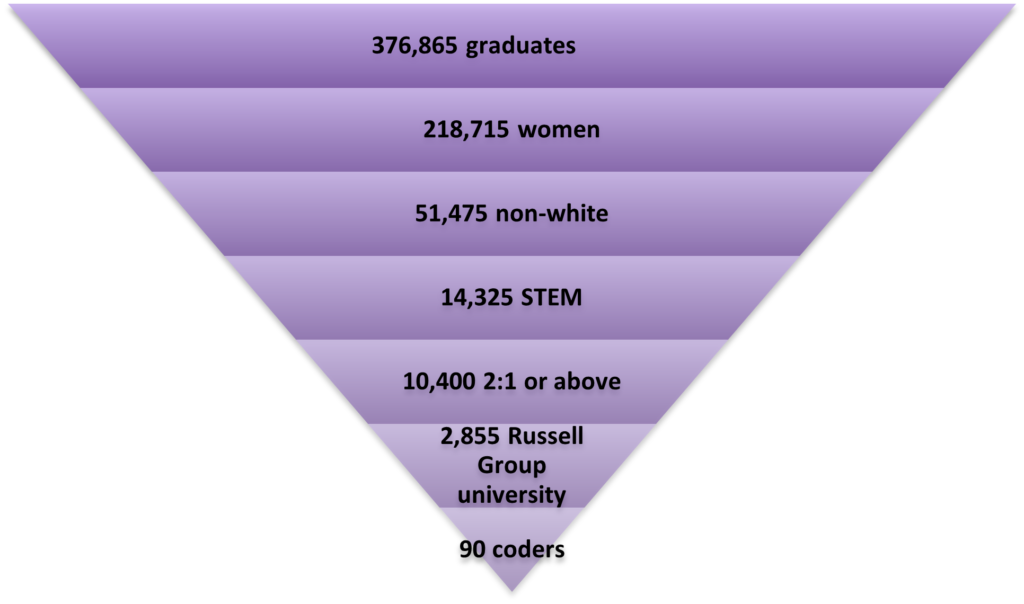3 ways to build a deeper graduate talent pool
Many graduate employers want quality, work-ready candidates from diverse backgrounds. But is there disconnect between expectations and the reality of graduate availability?
Do you know where the graduates you want tend to live, how they move about, how diverse they are? Do you know how your ‘wish list’ affects the depth of your talent pool?
A good understanding of the graduate talent pool is key to a successful attraction and selection strategy that can realistically achieve your KPIs.
At a recent ISE webinar we looked at Graduate Outcomes data to explain the surprising impact selection criteria can have on the availability of graduates and the subsequent depth of your talent pool.
3 ways to build a deeper graduate talent pool
1. Understand the size of your talent pool
The number of graduates broadly remain the same each year. In 2019/20, there were 376,865 graduates. Taking a hypothetical situation demonstrates the impact your selection criteria can have on the available talent pool.
If you would like to recruit non-white women coders who graduated with a 2:1 in STEM from a Russell Group university, you end up with just 90 graduates available across the whole of the UK (see inverted pyramid).
Understanding the size of the graduate talent pool before setting your attraction and selection strategy is key to ensuring your goals can be met.

Watch the ISE Prospects webinar (32 minutes in) to understand this in more detail.
Read Charlie’s blog on using Graduate Outcomes data
2. Consider the reality of graduate migration patterns
Despite nearly two decades and one major recession, graduates’ work-seeking behaviour, at least in geographic terms, remains reasonably constant. And it’s not what you would expect.
More than 40% of graduates do not move away from their home region for study or work 15 months after graduation. Around a quarter move away to go to university but return to their home region to work.
Only around 20% of graduates demonstrate what is often viewed as ‘typical’ – they move away from home to university and then move again, usually to a large city, on graduation. Nearly half of this group work in London and they are the largest group of graduates employed in the capital. They also tend to be from the most affluent backgrounds.
Read more on graduate migration patterns in the UK.
It is too early to see evidence of whether the shift to hybrid work has changed graduate migration patterns. I suspect that the link between location of work and location of employers may be eroding.
For example, a graduate wanting to work for a London firm may no longer need to move, but can stay at home and occasionally visit the office. Also, businesses in unpopular, expensive or remote labour markets can now recruit more widely.
At least for now, employers need to be mindful that they are likely to attract applicants who have an existing connection to the location of the business and that highly mobile graduates are less likely to be diverse. Highlighting opportunities for remote work can help employers deepen their talent pool and reach more diverse graduates.
3. Be more diligent about entry requirements
Reliance on a 2:1 as entry criteria is diminishing. Last year ISE reported that for the first time the number of employers stipulating a 2:1 degree as minimum entry criteria for graduate jobs had fallen to less than half.
Besides anything else, most students get a 2:1 and there’s little step change in quality between a graduate with a 2:2. If you want to increase the diversity of your talent pool, this is not the best marker. As illustrated in the first point, it’s also detrimental to the depth of your pool.
Perhaps if the labour shortage eases, a 2:1 requirement may return, but I doubt it will have the same importance. Those organisations that have moved away from it have found no real impact on the quality of applicants and a positive impact on diversity.
If you would like to understand your graduate talent pool in more detail contact Paul Naylor
You may also be interested in…
Is it time to try a new approach to talent pooling?
What you should know about Graduate Outcomes
Webinar: Why talent pooling is crucial to the new normal in early talent


0 Comments